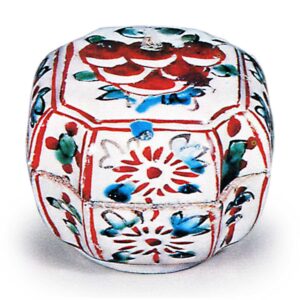
Also called akae-gosu. A bold design of mainly reddish green on a dyed or white porcelain base. It is estimated to have been produced from the end of the Ming dynasty to the beginning of the Qing dynasty, and was produced in southern China. Although there is no definitive theory regarding the kiln, the most popular theory is that it was produced in Shijiaozhou near Zhangzhou, Fujian Province. Both types of wares were actively exported overseas, and few examples remain in China today, but rather, many of them remain in Japan, the South Seas, Europe, and the United States. The best examples of the old color are prized by tea masters, and a single piece is said to fetch several million gold pieces. The majority of the vessels used are gosu bowls, plates, and jars, while vases, incense burners, water jars, bowls, and sake cups are extremely rare. There were few small dishes, and most of them were large dishes measuring between 22 and 33 centimeters and 43 to 44 centimeters in diameter, or so-called flat bowls. Many of the bowls are large bowls measuring 22 to 33 centimeters in diameter. Vases are rare, and vases are extremely rare. Goshi, or small vases, range in diameter from 2 to 3 to 7 or 8 centimeters, but there are few small ones. The types of red-painted gouzu vessels prized in the tea ceremony include red jade incense bowls, jade lion bowls, kaiote bowls, gouzu chrysanthemum and bamboo bowls, long-tailed bird bowls, fish bowls, kylin bowls, and blue gouzu dragon bowls, while large dishes are not so much appreciated. The “Ceramics” Vol. 4, No. 6 is a special issue on gosu-red glaze, in which opinions of various artists are collected. In addition, the “Illustrated Catalogue” contains about 60 illustrations of gosu-aka-e.



